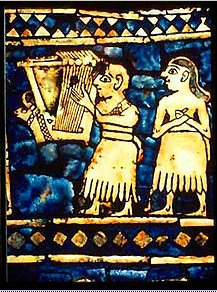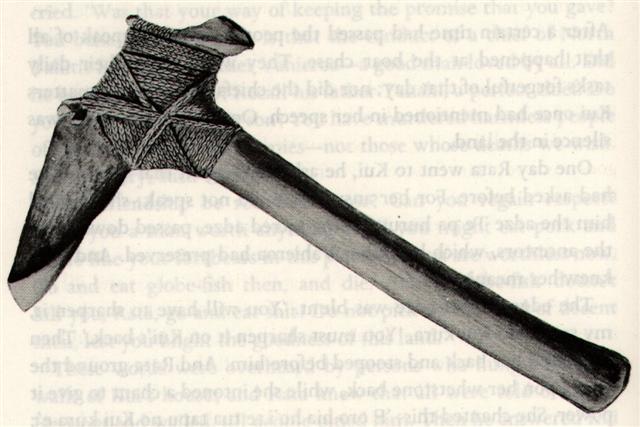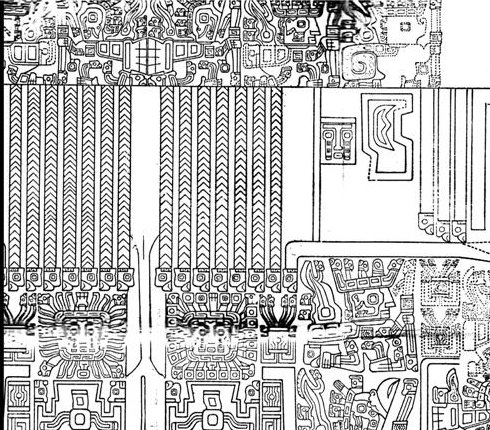3-3. According to suggestions of the Chinese the ruler was
no longer a fierce bull but an ox (he had been castrated and was now
a peaceful
beast).

|
Egyptian head |
 |
Phoenician
aleph |
 |
Greek alpha |
Α (α) |
|
In Gardiner's sign list this is E2,
aggressive bull. |
 . .

|
Jan 24 |
25 (13 * 30 = 390) |
26 |
27 (8 *
49 = 7 * 56) |
28 |
 |
 |
 |
 |
 |
|
Ea3-7 |
Ea3-8 |
Ea3-9 (74) |
Ea3-10 |
Ea3-11 |
|
te marama |
te marama |
kua oho - ki te vai |
te hoko huki - te kiore
kikiu |
te hokohuki - kiore
|
|
Vai.
Water, liquid, juice. 1. Vai tagata,
semen, sperm (also: takatea). 2.
Vai kava, saltwater, sea, ocean.
Vanaga. (Sweet) water.
Vai-kura
= blood. Barthel. 1. Water, liquid, fluid,
sap, juice, gravy, fresh water as differing
from tai seawater; hakavai to
dissolve, to liquefy, to melt. P Pau.:
ana-vai,
a brook. Mgv.:
vai, water. Mq.:
vai,
water, liquid, juice. Ta.:
vai,
sweet water, sap, juice.
Vaihu
(vai-u),
milk. T Mq., Ta.:
vaiu,
milk.
Vaipuga (vai-puna),
spring water. P Mgv.:
vaipuna,
water which springs from among stones. Mq.:
vaipuna,
spring water. Ta.:
vaipuna,
a spring.
Vaitahe (vai-tahe
1), river. 2. Pau.:
Vai,
to exist. Ta.:
vai, to be, to exist.
Vaiora,
to survive. Sa.:
vaiola,
the spring 'water of life?' Ma.:
waiora,
water of life.
Vaitoa (vai-toa
2), sugar. Mgv.:
vaito,
id. Vaituru
(vai-turu
1), water conduit.
Vaivai,
weak. PS Mq.:
vaivai, soft, pleasant,
agreeable. Sa., To.:
vaivai,
weak. Pau.:
Vaiho, to set down, to place.
Ta.: vaiiho,
to place. Ma.:
waiho, to set down. Pau.:
Hakavaivai,
to delay. Ta.:
vaivai, to rest a bit. Ta.:
Vaianu,
a plant. Mq.:
Vaimata, tears. Ha.:
waimaka,
id. Vaitahe,
a flood. Sa.:
vaitafe, a river. Ha.:
waikahe,
running water, flood.
Vaitupu,
spring water. To.:
vaitubu,
well water. Unuvai, to drink water;
hipu unuvai, drinking glass.
Churchill. Sa., Fakaafo, To., Fu., Niuē,
Uvea, Nukuoro, Ta., Rar., Tongareva, Mq.,
Mgv., Fotuna, Nuguria, Vaté: vai,
water. Rapanui: vai, juice, liquid,
water. Aniwa: vai, tavai,
water. Ma., Ha.: wai, id. Sikayana:
wai, wuai, id. Vi.: wai,
water. Rotumā: vai, voi, id.
Churchill 2. |
|
Ο Ursae Majoris (127.4)
*86.0 = *127.4 - *41.4 |
Pushya-8 (Nourisher)
υ Cancri (128.1),
θ
Cancri (128.2) |
Āshleshā-9 (Embrace)
/
Willow-24 (Stag)
π¹
Ursa Majoris,
δ
HYDRAE (129.6),
AL MINHAR AL SHUJĀ
=
σ
Hydrae, MUSEIDA =
π²
Ursae Majoris
(129.9)
RAS ALHAGUE (α Ophiuchi) |
Al Nathrah-6 (Gap)
BEEHIVE (Exhalation of Piled-up Corpses) = ε Cancri,
η Pyxidis (130.4), XESTUS = ο Velorum
(130.5), ζ Pyxidis (130.7),
ASCELLUS BOREALIS = γ Cancri, β Pyxidis (130.9)
*89.0 = *130.4 - *41.4 |
Extended Net-26a (Ox)
/
Arkū-sha-nangaru-sha-shūtu-12 (Southeast
Star in the Crab)
η
Hydrae
(131.0),
ASCELLUS AUSTRALIS =
δ
Cancri
(131.4),
KOO SHE =
Bow and Arrow =
δ
Velorum
(131.6),
α
Pyxidis (131.8),
ε
Hydrae
(131.9)
*90.0 = *131.4 - *41.4 |
 |
|
July 26 |
27 |
28 |
29
(210 →
420 / 2) |
30 |
 |
In the next week the central glyph denotes February 1
with a variant of henua
which I have named raaraa:
|
 |
 |
|
raaraa |
Ea3-15
(80) |
|
Ta.:
toraaraa,
to raise up. Churchill 2.
...
The chief thus makes his appearance at
Lakeba from the sea, as a
stranger to the land. Disembarking at
the capital village of Tubou, he
is led first to the chiefly house (vale
levu) and next day to the central
ceremonial ground (raaraa) of the
island ... |
... The cult place of
Vinapu is located between the fifth and
sixth segment of the dream voyage of Hau Maka.
These segments, named 'Te Kioe Uri'
(inland from Vinapu) and 'Te Piringa
Aniva' (near Hanga Pau Kura) flank
Vinapu from both the west and the east. The
decoded meaning of the names 'the dark rat'
(i.e., the island king as the recipient of
gifts) and 'the gathering place of the island
population' (for the purpose of presenting the
island king with gifts) links them with the
month 'Maro', which is June. Thus the
last month of the Easter Island year is twice
connected with Vinapu. Also, June is the
month of summer solstice [a mistake: south of
the equator it is winter solstice], which again
points to the possibility that the Vinapu
complex was used for astronomical purposes
...
 Possibly the month named Toki
was beginning here, viz. 33 days after day 364:
|
Dec 30 (364) |
*24
|
Jan 23 (388) |
|
 |
 |
|
Ea2-15 (47) |
Ea3-6 (71) |
|
July 1 (*102) |
July 25 (*126) |
| e tagata
hakakaikai toki |
toki
hakakaikai |
 |
| Jan
29 |
30 |
31
(396) |
Febr 1 (32) |
2 |
3 |
4 (400) |
|
... The Sacred Book of the ancient
Maya Quiche, the famous Popol Vuh (the Book of Counsel) tells of
Zipacna, son of Vucub-Caquix (= Seven Arata). He sees 400 youths
dragging a huge log that they want as a ridgepole for their house.
Zipacna alone carries the tree without effort to the spot where a hole
has been dug for the post to support the ridgepole. The youths, jealous
and afraid, try to kill Zipacna by crushing him in the hole, but he
escapes and brings down the house on their heads. They are removed to
the sky, in a 'group', and the Pleiades are called after them ... |
 |
 |
 |
 |
 |
 |
 |
|
Ea3-12
(77) |
Ea3-13 |
Ea3-14 →
π |
Ea3-15
(80) |
Ea3-16 |
Ea3-17 |
Ea3-18 |
| tagata mau toki |
ko te vae |
toki |
henua |
toki |
kiore - hokohuki |
kiore tupu |
|
... In China, with Capricornus,
Pisces, and a part of Sagittarius, it [Aquarius] constituted the early
Serpent, or Turtle, Tien Yuen; and later was known as Hiuen
Ying, the Dark Warrior and Hero, or Darkly Flourishing One, the
Hiuen Wu, or Hiuen Heaou, of the Han dynasty,
which Dupuis gave as Hiven Mao. It was a symbol of the emperor
Tchoun Hin, in whose reign was a great deluge; but after the Jesuits
came in it became Paou Ping, the Precious Vase. It contained
three of the sieu, and headed the list of zodiac signs as the Rat,
which in the far East was the ideograph for 'water', and still so
remains in the almanacs of Central Asia, Cochin China, and Japan
...

Tupu. 1.
Shoot, sprout, bud; to sprout, to bud. 2. Pregnant: vî'e tupu (o te
poki); to be conceived (of fetus in its mother's womb): he-tupu
te poki i roto i te kopú o toona matu'a. Vanaga. To grow, to sprout,
to germinate, to come forth, to conceive, pregnant, germ; mea tupu,
plant; tupu ke avai, of rapid growth; tupu horahorau,
precocious; hakatupu, to produce, to stimulate growth, to excite.
P Pau.: fakatupu, to raise up, to create. Mgv.: tupu, to
grow, to conceive, to be pregnant. Mq.: tupu, to grow, to sprout,
to conceive. Ta.: tupu, to grow, to sprout. Churchill. Mgv.:
Tupu, the best or worst, used of men or of bad qualities. Sa.:
tupu, king. Ma.: tupu, social position, dignity. Churchill.
... Another year passed, and a man by the name of
Ure Honu went to work in his banana plantation. He went and came to
the last part, to the 'head' (i.e., the upper part of the banana
plantation), to the end of the banana plantation. The sun was standing
just right for Ure Honu to clean out the weeds from the banana
plantation. On the first day he hoed the weeds. That went on all day,
and then evening came. Suddenly a rat came from the middle of the banana
plantation. Ure Honu saw it and ran after it. But it disappeared
and he could not catch it. On the second day
of hoeing, the same thing happened with the rat. It ran away, and he
could not catch it. On the third day, he reached the 'head' of the
bananas and finished the work in the plantation. Again the rat ran away,
and Ure Honu followed it. It ran and slipped into the hole of a
stone. He poked after it, lifted up the stone, and saw that the skull
was (in the hole) of the stone. (The rat was) a spirit of the skull (he
kuhane o te puoko). Ure Honu was amazed and said, 'How
beautiful you are! In the head of the new bananas is a skull, painted
with yellow root and with a strip of barkcloth around it.' Ure Honu
stayed for a while, (then) he went away and covered the roof of his
house in Vai Matā. It was a new house. He took the very large
skull, which he had found at the head of the banana plantation, and hung
it up in the new house. He tied it up in the framework of the roof (hahanga)
and left it hanging there ... |
|
γ
Pyxidis (133.6) |
ζ
Hydrae (134.1),
ρ
Cancri (134.2),
ζ
Oct.
(134.3), ο Cancri (134.6), δ Pyxidis (134.9) |
ACUBENS
= α Cancri,
TALITHA BOREALIS = ι Ursae Majoris
(135.0),
σ Cancri (135.2), ρ Ursa Majoris (135.6) |
ν Cancri
(136.0),
TALITHA
AUSTRALIS = κ Ursae Majoris
(136.1),
ω Hydrae (136.8) |
9h (137.0)
σ¹ Ursa Majoris (137.0), κ Cancri (137.3),
τ Cancri (137.4),
ALSUHAIL (al Wazn, of the
Weight) = λ Velorum
(137.5), σ² Ursa Majoris (137.6), τ Ursa Majoris (137.7), ξ Cancri
(137.8)
*96.0 = *137.4 - *41.4 |
κ
Pyxidis (138.0), ε Pyxidis (138.5) |
π
Cancri (139.2),
MIAPLACIDUS =
β
Carinae
(139.3),
TUREIS (Little Shield) =
ι
Carinae
(139.8) |
 |
|
July 31 |
Aug
1 |
2
(314 - 100) |
3
(210 + 5) |
4 (2 * 108) |
5 |
6 |
|
... It was 4 August 1968, and it was
the feast day of Saint Dominic, patron of Santo Domingo Pueblo,
southwest of Santa Fe. At one end of the hot, dusty plaza, a Dominican
priest watched nervously as several hundred dancers arranged in two long
rows pounded the earth with their moccasined feet as a mighty,
collective prayer [ui] for rain, accompanied by the powerful
baritone singing of a chorus and the beat of drums. As my family and I
viewed this, the largest and in some ways the most impressive Native
American public ceremony, a tiny cloud over the Jémez Mountains to the
northwest got larger and larger, eventually filling up the sky; at last
the storm broke, and the sky was crisscrossed by lightning and the
pueblo resounded with peals of rolling thunder ... |
The most compelling evidence we have for the
relevance of 396 - and after fractions have been
added 400 - is written on the upper dorsal side of
Pacha-mama:
...
Space and time are a single, related concept in Runasimi [the language of
the Inca people], represented by one word, pacha, which can also mean
'world' and 'universe' ..
|
Counting the tresses from
right to left: |
|
1 |
26 |
78 |
1 |
29 |
90 |
|
2 |
26 |
2 |
30 |
|
3 |
26 |
3 |
31 |
|
4 |
25 |
104 |
4 |
34 |
124 |
|
5 |
26 |
5 |
31 |
|
6 |
27 |
6 |
30 |
|
7 |
26 |
7 |
29 |
|
Total =
396 = 182 + 214 |

|

 .
.











